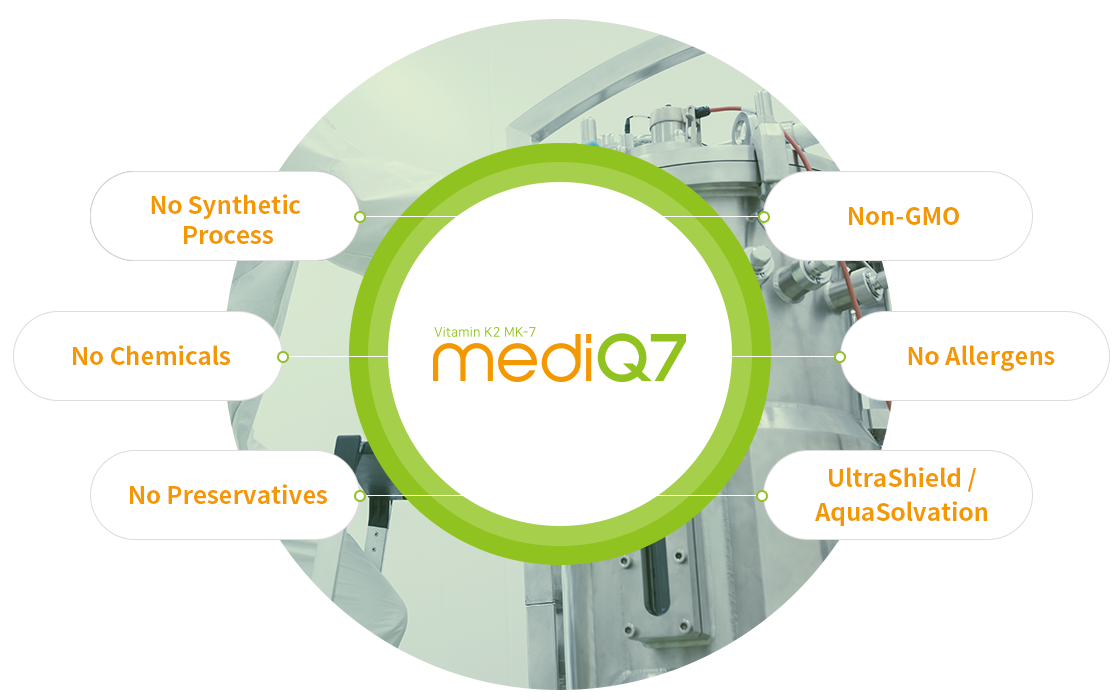Safe MediQ7®: Natural Fermentation
MediQ7® is a natural vitamin produced through supercritical extraction
technology and crystallization process by using patent strain
(KP10-2354881) Bacillus Subtilis natto, a high-purity vitamin K2 MK-7
derived from traditional Korean food called Cheonggukjang.
MediQ7® is manufactured with no synthesis process, no GMO, no chemical materials, and no preservatives used.
MediQ7® is manufactured with no synthesis process, no GMO, no chemical materials, and no preservatives used.

Chemical Synthetic K2 MK-7 VS Naturally fermented K2 MK-7
Chemical Synthetic vitamin K2 currently on the market are manufactured
using *toxic organic solvents and chemical catalysts, meaning there is a
high possibility that solvents and catalysts will remain in the final product.
MediQ7®, a naturally fermented Vitamin K2 MK-7, is a safe product acknowledged by self-affirmed GRAS (Generally Recognized As Safe) since it is manufactured through fermentation of Bacillus Subtilis natto, a microorganism from cheonggukjang.
MediQ7®, a naturally fermented Vitamin K2 MK-7, is a safe product acknowledged by self-affirmed GRAS (Generally Recognized As Safe) since it is manufactured through fermentation of Bacillus Subtilis natto, a microorganism from cheonggukjang.

Chemical Synthetic K2 MK-7 VS Naturally fermented K2 MK-7
Chemical Synthetic vitamin K2 currently on the market are manufactured
using *toxic organic solvents and chemical catalysts, meaning there is a
high possibility that solvents and catalysts will remain in the final product.
MediQ7®, a naturally fermented Vitamin K2 MK-7, is a safe product acknowledged by self-affirmed GRAS (Generally Recognized As Safe) since it is manufactured through fermentation of Bacillus Subtilis natto, a microorganism from cheonggukjang.
MediQ7®, a naturally fermented Vitamin K2 MK-7, is a safe product acknowledged by self-affirmed GRAS (Generally Recognized As Safe) since it is manufactured through fermentation of Bacillus Subtilis natto, a microorganism from cheonggukjang.

*The list of toxic organic solvents and chemical catalysts generally used in producing synthetic Vitamin K2 MK-7
| Chemicals | Name | Hazards |
| tBuOOH | Tert-Butyl hydroperoxide | Exceptionally dangerous. Highly reactive. Flammable. Toxic, Corrosive to skin and mucous membranes. Causing respiratory distress |
| CH2CI2 | Dichloromethane (DCM or methylene chloride) | Highly volatile. Acute inhalatioin hazard. Acute inhalatioin hazard. |
| MsCI | Methanesulfonyl chloride (mesyl chloride) | Highly toxic by inhalation Corrosive |
| DMAP | 4-Dimethylaminopyridine (DMAP) | Highly toxic. Absorbed through the skin. Corrosive |
| DCM | Dichloromethane (DCM or methylene chloride) | Highly volatile. Acute inhalatioin hazard. Acute inhalatioin hazard. Carcinogenic |
| BrCH2CH2Br | 1, 2-Dibromoethane | Causing changes in the metabolism. Severe destruction of living tissues |
| PBr3 | Phosphorus tribromide | Corrosive. Toxic. Violent reaction with water and alcohol |
| AC2O | Acetic anhydride, or ethanoic anhydride | Irritant. Combustible |
| Salicylic acid | Salicylic acid | High levels of salisylic acid. Can enter the blood |
| THF | Tetrahydrofuran (THF), or oxolane | Highly explosive peroxidation |


